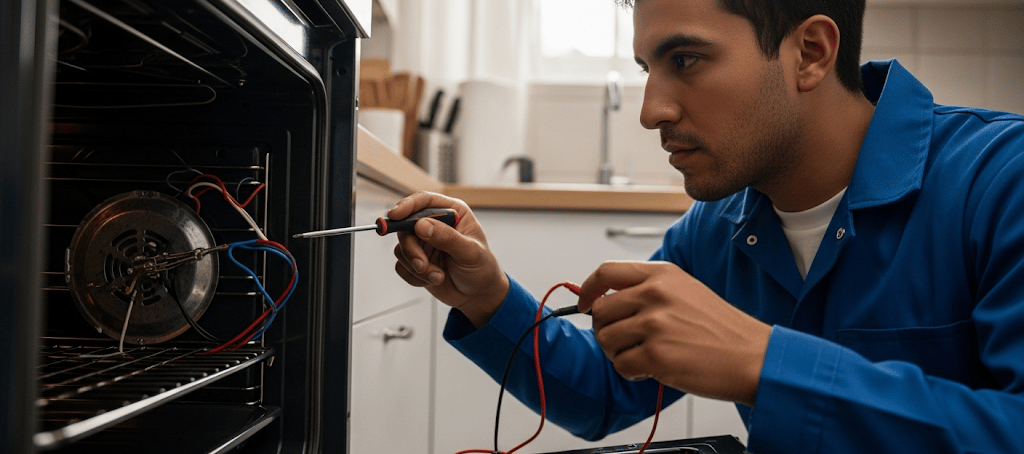DIY Oven Repair for Beginners: Tackle Uneven Heating & Faulty Controls
Explore essential repair techniques for common oven issues like uneven heating and faulty temperature controls. This post offers step-by-step guidance to help you safely diagnose and fix your oven without the need for professional help, saving you time and money.
ARTICLE
Atanu Yadav
5/28/20254 min read


Introduction:
Is your oven acting up? Unevenly baked cookies or a roast that's half-raw can be incredibly frustrating. Before you call a professional and brace yourself for a hefty bill, consider diving into the world of DIY oven repair! Many common oven issues, like inconsistent heating or temperature control problems, can be diagnosed and fixed with a little know-how and some basic tools. This guide is designed for beginners, offering step-by-step instructions to help you safely get your oven back in top shape, saving you time and money. Let's get cooking!
Section 1: Safety First! Before You Begin Any Repair
Unplug the Oven: This is the absolute most crucial step. Always unplug your oven from the wall outlet or flip the circuit breaker off before touching any internal components.
Allow Cooling: If you've recently used your oven, give it plenty of time to cool down completely.
Wear Protective Gear: Consider wearing work gloves to protect your hands from sharp edges and safety glasses to shield your eyes from any debris.
Consult Your Manual: Your oven's user manual is a treasure trove of information, including wiring diagrams and troubleshooting tips specific to your model.
Section 2: Diagnosing Common Oven Issues
Issue 1: Uneven Heating
Symptom: Food is burned on one side and undercooked on the other, or certain areas of the oven seem hotter/cooler.
Possible Causes:
Faulty Baking Element: The heating element at the bottom of the oven might be partially burnt out or developing hot spots.
Faulty Broil Element: If the top of your food is burning, the broil element (top of the oven) might be the culprit.
Malfunctioning Convection Fan (for convection ovens): The fan that circulates hot air might not be working correctly.
Incorrect Oven Rack Placement: Food placed too close to a heating element can cook unevenly.
Issue 2: Faulty Temperature Controls / Oven Not Heating to Correct Temperature
Symptom: Oven temperature displayed doesn't match a separate oven thermometer, or food consistently bakes too quickly or too slowly.
Possible Causes:
Faulty Temperature Sensor (Thermistat): This small probe inside the oven sends temperature readings to the control board. If it's dirty, damaged, or malfunctioning, it can lead to inaccurate readings.
Calibration Issues: Sometimes, the oven's temperature simply needs to be recalibrated.
Control Board Malfunction: Less common, but a faulty control board can misinterpret temperature signals.
Loose Wiring: A loose connection to the heating elements or temperature sensor can prevent proper function.
Section 3: Step-by-Step Troubleshooting and Repair
Troubleshooting Uneven Heating:
Visual Inspection of Heating Elements:
Open your oven door and visually inspect both the bake element (bottom) and the broil element (top).
Look for any visible damage like cracks, blisters, or areas that look discolored or burnt out. A healthy element should appear uniform.
If you see any obvious damage, the element likely needs to be replaced.
Testing Heating Elements (Multimeter Recommended):
Safety First! Unplug the oven.
Carefully remove the screws holding the element in place.
Gently pull the element out a few inches to access the wires connected to its terminals.
Using a Multimeter: Set your multimeter to the Ohms (Ω) setting. Place one probe on each terminal of the element.
Reading: A good heating element will show a resistance reading (typically between 10 and 50 ohms). If the multimeter shows "OL" (open loop) or no reading, the element is likely faulty and needs replacement.
Checking Convection Fan (for convection ovens):
Safety First! Unplug the oven.
Locate the convection fan, usually at the back of the oven.
Gently try to spin the fan blades by hand. They should spin freely. If they are stiff or make grinding noises, the motor might be seizing.
You can also try to listen for the fan operating when the convection mode is selected (briefly plug in and turn on, then immediately unplug). If you hear no sound, the motor might be faulty.
Troubleshooting Faulty Temperature Controls:
Locating the Temperature Sensor:
The temperature sensor is typically a thin, metal probe protruding into the oven cavity, often located at the top rear or side.
Visual Inspection of Temperature Sensor:
Check the sensor for any visible damage, kinks, or signs of burning. Ensure it's securely mounted.
Make sure there isn't any grease or food debris coating the sensor, which can interfere with accurate readings.
Testing Temperature Sensor (Multimeter Recommended):
Safety First! Unplug the oven.
Carefully remove the sensor from its mounting bracket.
Disconnect the wires leading to the sensor.
Using a Multimeter: Set your multimeter to the Ohms (Ω) setting. Place one probe on each terminal of the sensor.
Reading: The resistance of a temperature sensor changes with temperature. At room temperature (around 70°F/21°C), a healthy sensor typically reads around 1090 ohms. As it gets warmer, the resistance should increase. If you get an "OL" reading or a significantly different reading, the sensor is likely faulty.
Oven Calibration (Consult Your Manual):
Many ovens have a temperature calibration feature that allows you to adjust the oven's temperature up or down by a few degrees. Refer to your oven's user manual for specific instructions on how to access and use this feature. This is often done through the control panel.
Section 4: When to Call a Professional
While many issues are DIY-friendly, some problems require professional expertise. If you're in Beleghata and find yourself struggling with a complex oven issue, or simply don't have the time or tools for a DIY fix, don't hesitate to reach out to Proyojani Reparing Centre. Our experienced technicians are well-versed in all major appliance repairs, ensuring your oven is back to perfect working order quickly and safely.
Gas Leaks: If you smell gas, immediately turn off the gas supply to your home and evacuate. Call a professional gas technician or your gas company. Do NOT attempt to fix this yourself.
Complex Electrical Issues: If you suspect a problem with the main control board or internal wiring and you're not comfortable working with electricity, it's best to call a qualified appliance technician.
Persistent Issues: If you've tried the above troubleshooting steps and your oven is still not functioning correctly, it's time to seek professional help.
Warranty Concerns: If your oven is still under warranty, attempting DIY repairs might void it. Check your warranty terms before proceeding.
Conclusion:
By following these step-by-step instructions, you've hopefully gained the confidence to tackle common oven issues and potentially saved yourself a service call. Remember, patience and safety are key. Regular cleaning and a little preventative maintenance can also go a long way in keeping your oven running smoothly. Happy baking, and enjoy your perfectly cooked meals!
Proyojani Repairing Centre
Premium appliances for every culinary enthusiast's needs.
© 2025. All rights reserved.
Contact
117/B Hemchandra Naskar Road, Phoolbagan, 700010
